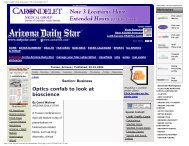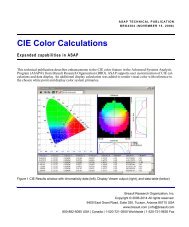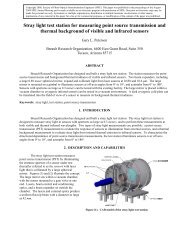46.3: An Efficient Illumination System for Single-Pane LCD Projector
46.3: An Efficient Illumination System for Single-Pane LCD Projector
46.3: An Efficient Illumination System for Single-Pane LCD Projector
You also want an ePaper? Increase the reach of your titles
YUMPU automatically turns print PDFs into web optimized ePapers that Google loves.
<strong>46.3</strong> / L. C. Lingbetween the shapes of illuminating light beam andactive area of the <strong>LCD</strong> panel.It is to be noted that integrator rod approach hasalso been used to build illumination system <strong>for</strong>single panel <strong>LCD</strong> projector 4 . This approacheliminates the problems of shape mismatch andinefficient usage of sub-pixels’ open aperture.But polarization conversion can not be easilyimplemented to improve the system efficiency.pblack matrixtransmittingaperturea b(a) (b) (c)Fig. 1 Sub-pixel structure and light distribution onthe center sub-pixel <strong>for</strong> (a)inefficient, (b)efficientbut color mixing, and (c)optimum use of sub-pixelaperture.Brightness and saturated color are two of themajor metrics <strong>for</strong> evaluation of per<strong>for</strong>mances of aprojector. It is important <strong>for</strong> modern projectorsto have maximum optical efficiency and goodcolor per<strong>for</strong>mances. Even <strong>for</strong> rear projectionapplications, high brightness is desired to alleviatethe requirements on the projection screen 5 . Inthis paper, we describe an illumination system thatis tailored to give maximum optical throughputwithout color mixing on a single panel <strong>LCD</strong>projector that use angular color separation <strong>for</strong>synthesis of full color images.RecycleMirrorPS-ConverterwDesign of the <strong>Illumination</strong> <strong>System</strong>The optical layout of the illumination system isillustrated in Fig. 2. The design of illuminationsystem is essentially the same as that ofthree-panel type <strong>LCD</strong> projectors with two distinctmodifications.The illumination system consists of an arc lampwith parabolic reflector, a first and a secondintegrator lens array, a pair of recycle reflectors, aPS-converter, a condenser lens, a collimating lens,and a three-filter dichroic mirror assembly.The elements of the first lens array divide thelight beam from the lamp and image the arc intothe apertures of the second lens array. Thesecond lens array and the condenser together <strong>for</strong>msuperimposed images of the elements of the firstintegrator lens array on the display. This allowsthe system to trans<strong>for</strong>m the circular beam from thelamp to the display’s rectangular shape and tohomogenize the intensity distribution across theilluminated area. The collimator lens makes thelights telecentric be<strong>for</strong>e entering the dichroicmirror assembly.The dichroic mirror assembly produces red,green, and blue light beams with appropriateangles of incidence to the <strong>LCD</strong> panel. Afterentering the panel, the micro-lens array focusesthe color beams onto their respective sub-pixels.ProjectionLens<strong>LCD</strong><strong>Pane</strong>lScreenFieldLensIntegratorLens ArrayCondenserLensCollimatingLensFig. 2 Optical layout of the illumination systemDichroic MirrorsAssemblySID 01 DIGEST • 1185
<strong>46.3</strong> / L. C. LingThe micro-lens re-images the arc images <strong>for</strong>medby the first lens array onto the open aperture ofeach sub-pixel, as illustrated in Fig. 1(c) <strong>for</strong> thegreen beam. The width and height of thearc-image cluster is a function of the focal length ofmicro-lens and the f-number of the telecentric lightbeam illuminating the display.For no color mixing, the width of the imagecluster w should be at least smaller than p+b, and toobtain maximum optical efficiency, w should beless than a. Due to the unavailability of very shortarc lamp, compromise usually needs to be made onoptical efficiency.The first distinct feature of the illuminationsystem is that the two integrator lens arrays have anelongated shape similar to that of sub-pixels toprovide an illumination beam with appropriatef-numbers in the width and height direction. Withsuch an integrator lens design, the f-number in thewidth direction of panel’s sub-pixel is sacrificed <strong>for</strong>angular color separation. But in the height direction,small f-number is preserved <strong>for</strong> optical efficiency.Because the light beam emerging from the lamphas a cross section wider than the elongated lensarray, the first lens array can not collect all thelights emitted from the source unit. The seconddistinct feature of the illumination system is thatreflectors are placed on both side of the first lensarray to redirect the lights missed by the lens arrayback into the lamp unit 6 . A fraction of these lightswill have proper angles to pass through the arc andemerge within the region covered by the first lensplate and become useful to the system, asillustrated by one of the possible the ray path in thelamp unit in Figs. 2.Computer SimulationComputer simulation of the illumination systemusing ASAP is per<strong>for</strong>med to evaluate the opticalthroughput efficiency. A 1.6” SVGA panel isused in the simulation. The panel has a pixel sizeof 40.5µm, which corresponds to a sub-pixel pitchof 13.5µm. The width of the black matrix isassumed to be 5µm (p=13.5µm, a=8.5µm, b=5µmin Fig. 2). Focal length of the aspheric micro-lensarray is approximately 140µm in air, which placethe focal plane slightly after the pixel electrode.The geometric structure of the panel is shown inFig. 3.RGBmicro-lenscover glasscommonelectrodepixelelectrodeblack matrixFig. 3 Structure of the <strong>LCD</strong> panel used insimulation.The integrator lens array consists of 4x12rectangular elements. A dummy PS-converter isplaced between the second integrator lens arrayand the condenser lens to simulate the geometriceffects of the PS-converter. To match with themicro-lens’ f-number and sub-pixel pitch, thedichroic mirrors are adjusted to have an angle of3.5 degree between each other. In thissimulation, the green light is allowed to incidenton the panel normally.The lamp used in the simulation is modeled withASAP based on lamp data <strong>for</strong> a Matsushita 150Wultra-high pressure mercury lamp. The arc gap is~1.1mm and the reflector size is 70x65mm. Thearc is modeled with a nest of ellipsoid volumeemitters. Fig. 4 shows the quartz bulb,electrodes, and the shape of the arc in the lampmodel.Fig. 4 Lamp model used in the simulation.1186 • SID 01 DIGEST
<strong>46.3</strong> / L. C. LingThe computed light distribution after the pixelelectrode is shown in Fig. 5. The sharp verticaledges indicate that the arc image cluster is widerthan the open aperture of each sub-pixel.However, no color mixing is observed in thesimulation result. Note that idea dichroic mirrorsand micro-lens were assumed in the simulation.Fig. 5 Computed light distribution on a planright after the pixel electrode.The computed geometrical efficiency after thepixel electrode is about 0.3 without the recyclereflectors. With recycle reflectors, the efficiencyincreases to 0.34. Assuming efficiencies of 0.7<strong>for</strong> polarization effect, 0.7 <strong>for</strong> interfaces anddichroic mirrors, and 0.85 transmittance <strong>for</strong> the<strong>LCD</strong> panel and projection lens, the total systemefficiency should be more than 10%.Experimental ResultsA commercially acquired single panel projector(Lightware’s Scout) was modified to implementthe illumination system. Only the dichroicmirror assembly, <strong>LCD</strong> panel, and the projectionlens of Scout were retained <strong>for</strong> the experiment.The rest of the optics were from other sources andthe specs of these optics were not optimized <strong>for</strong>this application. The brightness and uni<strong>for</strong>mitydata are summarized in the following table.Brightness Uni<strong>for</strong>mityW/o recycle reflector 545 ANSI lm 87%With recycle reflector 590 ANSI lm 85%DiscussionWe have presented a single panel <strong>LCD</strong> projectordesign that is capable of high efficiency, gooduni<strong>for</strong>mity and saturated color per<strong>for</strong>mance.One drawback of angular color separation methodis the panel’s pixel count has to be three times theresolution of the panel. It may not be very costeffective to produce such panels with resolutionhigher than SVGA using HTPS process.However, with LTPS process such as CGS, it maybecome economically feasible to producelarger-sized panels to accommodate the higherpixel count. We believe that high resolutionLPTS panels used with the illumination systemdescribed in this paper has the potential to be themost af<strong>for</strong>dable solution <strong>for</strong> high quality homeand business projection applications.AcknowledgementsThe authors acknowledge Drs. J. C. Yoo, S. Weiand others at Q200 of OES/ITRI <strong>for</strong> their helpwith the experiment.References[1] J. Shimizu “<strong>Single</strong> <strong>Pane</strong>l Reflective <strong>LCD</strong>Optics”, IDW ’99, pp989-992 (1999)[2] H. Hamada et al., “A New Bright <strong>Single</strong> <strong>Pane</strong>lLC-projection <strong>System</strong> Without a Mosaic ColorFilter”, IDRC ’94, pp422-423 (1994)[3] H. Hamada, “Optical <strong>System</strong>s <strong>for</strong>High-Luminance LC Rear Projection”, SID 96,pp911-914 (1996)[4] K. Kaise et al., “Liquid Crystal <strong>Pane</strong>l HavingMicro-lens Array with Extended Focal Length andDisplay Apparatus Having the Same”, US Patent,6,002,459 (1999)[5] C. McLaughlin, “Comparison of MicrodisplayBased Rear Projection Televisions”, ProjectionDisplay 2000: Sixth in a Series, SPIE Vol. 3954,pp214-219 (2000)[6] S. Ohuchi et al., “Compact LC <strong>Projector</strong> withHigh-Brightness Optical <strong>System</strong>”, IEEETransactions on Consumer Electronics, 43, No. 3(1997), p.801.SID 01 DIGEST • 1187
















